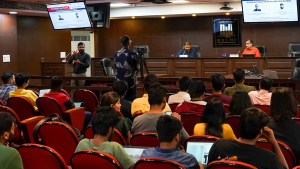The Vidhi Centre for Legal Policy and Rainmatter Foundation, in association with Collective for Environmental Action of National Law University, Delhi organised the fourth episode of THE GREEN MANDATE- Season 2 on ‘Introduction of African Cheetahs in India’ with noted wildlife biologist & conservation scientist Dr Ravi Chellam at National Law University, Delhi on 19th October 2023.
The cheetah was officially declared extinct in India in 1952. In 2009, the ‘African Cheetah Introduction Project in India’ was initiated, but it took a decade for substantial progress to be made. The Supreme Court established a three-member committee to oversee the introduction plan, and it granted its final approval in January 2020. Following a delay caused by the COVID-19 pandemic, the ‘Action Plan for the Introduction of Cheetah in India’ was unveiled in 2022. The plan involves the relocation of 50 cheetahs over the next 5 years, with approximately 10-12 cheetahs being brought from South Africa and Namibia in the first year.In September 2022 and February 2023, a total of twenty cheetahs were translocated to Kuno National Park (KNP) from southern Africa. Currently, more sites are under consideration for introducing cheetahs. Unfortunately, there have been nine deaths, including six adult cheetahs and three cubs. The recording of the discussion is now available on YouTube. The following is a transcript of significant discussion points from the talk.
The discussion in the fourth episode of THE GREEN MANDATE Season 2 focused on the project’s alignment with conservation priorities and the potential impacts on native species and ecosystems.
Question – You have been a prominent advocate for conservation and a vocal critic of the cheetah introduction project. Before we go into the specifics of the cheetah Introduction project, I would like to ask a fundamental question: are your objections directed at the project as a whole, or do they primarily revolve around the selection of Kuno National Park, which you believe could hinder the Asiatic Lion introduction plan?
The government of India sponsored my doctoral research to collect data to inform a translocation of the lions. After my PhD, I was commissioned to survey northern India and western India to find suitable habitats for the translocation of lions. Through that survey, we recommended Kuno as a habitat for lion translocation. The government of India agreed and released crores of rupees to the state of Madhya Pradesh to manage Kuno and prepare it for the lions. I have presented the scientific rationale, the ecology of the animal, and what it requires. The NTCA appealed the 2013 judgement on lion translocation, stating that it will not interfere with lion translocation and not look at Kuno for introducing cheetahs. So there is an ecology issue and a rule of law issue.
Moreover, Africa is both the native and the best habitat for the cheetahs; how will they survive in Kuno? Any way you look at it, I don’t see any logic, scientific rationale, conservation priority, or financial viability for introducing African cheetahs in India. To answer your question directly, it started with the lion translocation, but as I read more about the cheetahs, I realised it could not be a viable project.
Question – Proponents of the cheetah introduction project, including the government of India and supportive conservationists, argue that the initiative aims to shift the conservation focus towards “grassland” ecosystems, which have been somewhat neglected by current policies and administrations. What are your thoughts on this perspective?
Restoring a habitat requires drastic interventions over a long period and large spatial scale, i.e., hundreds of square kilometres. For the lions to be translocated, about 1500 families in nearly 30 villages were resettled. As a result, the native vegetation has come back. Kuno is not your typical open natural ecosystem. There are patches of grassland, but it is a dry deciduous forest. It has had tigers and lions before; it continues to have Leopards, Sloth Bears, Hyenas, and Wolves. The Action Plan for cheetah introduction released in January 2022 records that Kuno is the most suitable habitat because it has been managed for the translocation of lions. It is well protected and has sufficient prey species. But more recently, the same people involved in writing the action plan and other South African and Namibian scientists are now saying that Kuno is not a suitable habitat because of its size and prey density. So, we do not know what to believe; from official sources, we are getting conflicting information.
Question – Currently, we stand at a juncture where 20 adult African cheetahs have already been introduced, with 14 surviving. There are plans to bring 30 cheetahs from Africa over the next 3-4 years. According to the officials from the National Tiger Conservation Authority (NTCA) overseeing this project, there have been no unnatural deaths thus far. An interview with an NTCA officer suggested that cheetahs are highly adaptable to various environments, including coastal areas, mountainous regions, scrub forests, and even snowy areas. Kuno was selected based on scientific studies and is deemed superior to South Africa’s habitat for cheetah reintroduction. Given your expertise as a conservation scientist, I’d like to hear your perspective on this, particularly regarding whether Kuno constitutes a suitable habitat for the cheetahs.
Cheetahs exist in densities ranging from 0.25 to 2.5 per 100 sq kilometres So it depends; when you say Africa, do you mean 0.25 density or 2.5 density? Additionally, 10,000 sq km can have up to 250 cheetahs or as low as 4 to 20 cheetahs. Data has to be provided; I cannot counter mere opinions.
Question – In your experience, how do you envision the future of Kuno National Park and its wildlife diversity being impacted by the cheetah Introduction Project? Can we anticipate a scenario where all four major carnivores—Lion, Tiger, Leopard, and Cheetah—coexist in the same habitat?
People think that the tigers drove the lions away. There is no logic there. Historically, in India, there have been habitats where lions, tigers, leopards, and even cheetahs would have coexisted, but at what scale? It is in the landscape scale because tigers and leopards would take the more rugged, wetter habitats, and lions and cheetahs would take more flatter, open habitats. Today, in Africa, lions and cheetahs live together. It is not as if the large carnivores have not coexisted. Tigers have existed in Gujarat, and lions have been found in Bengal. It is not as if they have not “coexisted.” There will be clashes, but animals find their way; we are talking about decades and centuries of evolution and adjustment. Suddenly bringing a few cheetahs from Africa to recreate this garden of Eden, I don’t know, but ecology and environmental history tell us that they would have coexisted historically.
Question – What constitutes a successful outcome for this project, even if it’s on a limited scale? The government is contemplating the introduction of African Cheetahs in other National Parks and Sanctuaries.
Forget cheetahs; for any reintroduction program, the success is defined by the persistence of the population. To put it differently, after a number of years, the reintroduced population will become self-sustaining, then it will be a success story. But again, I go back to the point that without a habitat, how can you start a family? So that is going to be the challenge. In the few weeks we have had the cheetahs ranging free in India, they have had a team of 4-5 people tagging every cheetah every minute of its life. How can you expect an animal to settle down and be wild if you have so much scrutiny over its day-to-day life?
“Why are the Cheetahs still in captivity? You brought them to release them into the wild, you brought to save your grasslands… why do you keep capturing and bringing them back into captivity? How are they going to do their job?“
– Dr. Ravi Chellam
Question – We have seen instances of the cheetahs being tranquilised while naturalising and trying to go places to be brought back to Kuno. Secondly, there is an issue of free-ranging domestic dogs conflict with wild animals. How can we deal with this conflict in regard to the cheetahs?
I do not think capturing and bringing back the released animal is the right approach. And cheetahs are wide-ranging; they can move up to a thousand kilometres. In this case, the first cheetah to be released, Pawan, was captured and brought back multiple times. However, is this the way to treat a wild animal? To me, this is more of management to try and show that you are managing rather than allowing ecology and conservation science to inform your management. Dying is not bad; it is the only guarantee in all our lives. You cannot let the fear of death dominate how you intervene. On the issue of free-ranging dogs in wildlife habitats, we have flagged it from a disease perspective, and they can gang up to ravage the resident wildlife of an area. Fortunately, it has not happened yet but is a real danger. Secondly, there is a danger of cheetahs dying on the highways as well, which is the biggest cause of cheetah deaths in Iran as well. In South Africa, these cheetahs are housed in fenced reserves ranging from a hundred to a thousand square kilometres. India does not have fenced reserves because people also access the resources. We have made many foundational errors while transplanting South African ideas into India without thinking them through and also by not considering the spatial ecology of the cheetah.
Question – We have been seeing the government’s focus move towards ecotourism. Do you think there has been any transformation in government policies towards conservation? And what do you think is lacking in this shift?
Unfortunately for most of us, there is a strong streak of ecological illiteracy and technological arrogance. We think technology can solve all our problems. There is also a fundamental mismatch of timelines. Ecology and evolution work on a very different timescale while corporate results and elections operate completely differently. How you navigate this is bringing in ethical issues; issues related to the environment or the local community have to be viewed through what is right and wrong and not through what is profitable and what is not. Nature has shown us repeatedly; just look at the last 10 years, Uttarakhand floods, Himachal and Bombay floods; this is not happening because nature wants it to happen but because we have built things this way and continue doing things this way. Our inability to use ethics and morals in our lives and see ourselves as external to nature and not a part of it has led to this. We are also biodiversity; the nature of how we view things has to be changed because when nature strikes, we do not have any answers.
“Is it India’s responsibility to conserve African Cheetahs?”
– Dr. Ravi Chellam
Audience Questions
Question – Considering the number of cheetahs (500-1000) that will perish in this project, why aren’t large groups like the IUCN looking at this and saying we cannot let this happen?
I think more and more people should directly write to IUCN regarding our concerns on this project. I have been given the respect of no response. I have written to the chairperson of IUCN’s Cat Specialists Group and sent reminders, but I have been treated like a nonentity. Forget the moral and ethical obligations; the African cheetah population cannot afford to lose that high number of cheetahs. And multiple people have written about this.
Question – Could you highlight the implications of classifying certain areas as wasteland and utilising them for various projects?
It is our obsession with the tall and the green. We look at tall evergreen forests as good forests and anything else as bad forests. It again stems from ecological illiteracy. Natural vegetation is expressed as a function of the terrain, species composition, temperature, and rainfall; we do not decide. Nature decides for itself. So when it comes to these open natural ecosystems, a “typical forester” will look at it and say it is a wasteland. Unfortunately, India has fallen into this trap of wanting to do everything on the biggest scale. We have the largest solar farm. But what is the cost of running this large solar farm? It requires fresh water if you put it in dry areas where you will get fresh water from. There seems to be no thinking on these issues. Additionally, Indian citizens seem to have lost their voices largely; local communities definitely have it, but people living in cities do not engage with issues outside of their daily lives. We have to invest more in what our visions for India are.
Question – Why do you think the translocation of lions did not happen, and why is it important?
Before I answer your question, you must remember that the Supreme Court on 15 April 2013 explicitly ordered the translocation of lions. The exact words are, “In letter and spirit, the lions should be translocated from Gir to Kuno within six months.” Today is 19 October 2023, and the lions have not been translocated; it is a serious legal issue that a Supreme Court order is not being followed. I would say it is impunity; certain people believe they are above the law. Unfortunately, the Courts are not even recognising this. The official reason from the State of Gujarat is that the IUCN guidelines have not been followed, so lions cannot be translocated. Are the IUCN guidelines being followed for the cheetahs? If Kuno is good enough for African cheetahs, it is good enough for our neighbouring lions. The reason being given for the cheetah introduction is that the African cheetah population has a surplus, and they do not have enough space for the cheetahs. But that’s not true; as discussed during my presentation- 14 out of 18 cheetah populations are actually on the decline. Even if it is true, it’s not India’s duty to conserve African cheetahs.
On the question of the importance of translocation of lions, it is a safety net. You do not keep all your eggs in one basket. The lions have gone through what is called a genetic bottleneck. In the late 1800s and early 1900s, the lion population was estimated to be close to extinction. The lions have made a remarkable comeback; we need to acknowledge how successful we have been in conserving the lions. But if all your lions are in one place, they are prone to being wiped out by a disease outbreak. For example, the Serengeti Mara ecosystem in 1994 had 3000 lions, and canine distemper and babesiosis wiped out 1000 lions. That is what happened in 2018 in India; 3 dozen lions died in a matter of days. 3 other dozens of lions were taken into captivity, those lions are still in captivity. They have been lost to the wild population, and lions are continuing to die. We do not want to tempt fate. It is very unlikely that the same outbreak would happen if lions were in two places instead of one.
“If Kuno is good enough for African Cheetahs, it is definitely good enough for our own neighbouring (Asiatic) Lions to come from (Gujarat).”
– Dr. Ravi Chellam
Question – We have been looking at the cheetah project from the perspective of whether the cheetahs survive or whether Kuno is an appropriate site. But what is the effect of introducing a foreign species into India and its impact on the native species and the biodiversity?
It will have an impact, but the impact will not be visual. What I mean is that it is not going to impact large vertebrates or something that you can see; it will happen at the microbial level. It could be the bacteria they carry, the diseases they carry, or the diseases they get in India. I suspect some of the deaths in July were due to a disease the African cheetahs were not exposed to prior to coming here.
To watch all episodes of The Green Mandate, visit our YouTube playlist.





